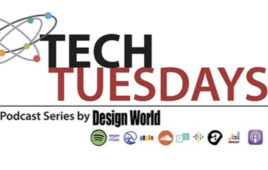[A lightly edited transcript follows …]
DW: Welcome to Design World’s executive edition. I’m Paul Heney, VP and Editorial Director. Today I’m pleased to have Mike Rennie, the General Manager for Adaptall, in Mississauga, Ontario on the podcast with me. Welcome, Mike.
MR: Thanks for having me, Paul.
DW: Certainly. Well, Mike and I were chatting at the Fluid Power Distributor Association’s industry summit in Lake Tahoe last month, and we were going over Adaptall’s varieties of adapters and fitting solutions, as well as their pretty interesting custom manufacturing business. It sounds like they’ve been keeping awfully busy up there in the Toronto area. So Mike, can you talk to us a little bit about some of the trending topics that you might see in the fittings business today?
MR: Yeah, sure, Paul. There’s definitely a lot going on. One trend we’re seeing amongst the fitting companies right now is the popularity in fitting kits. These typically include plugs and caps of various thread types or seals. These are really popular because they allow the distributor or end user to stock a wide variety of sizes without the need for bins or excess shelf space. They can literally just put it underneath their shelf or put it in their mobile trucks. Very, very convenient. Or the end user themselves, they can buy the whole kit and have those universal solutions available to them.
We find these plug and cap kits are specifically great for thread identification in the shop or, again, in your home shop, mobile hose trucks when they’re out on the road, or even capping or plugging off hose lines for maintenance. That’s a big one we’re seeing right now, and we’re adding new kit lines almost constantly. So yeah, check out our website and those should be up shortly.
We’re also seeing big trends in terms of alternative fitting styles replacing some of the traditional fitting technologies. The main one we’re seeing is DIN tube fittings are beginning to replace, in some situations, not all, but they are starting to replace some of the JIC threads in OEM applications, simply due to their higher pressure loads. They’re also less prone to damage while being torqued. A lot of people know that JIC tend to crack at the nose cone, or deform at the nose cone, and they’re not really reusable. There’s a lot of inherent downsides to it, so DIN seems to go around a lot of those.
The other one we’re seeing is banjo fittings, which are typically used in automotive or heavy equipment applications. They’re starting to be used in some OEM and non-heavy equipment or automotive applications. This is simply for the low profile clearance and the orientation advantages. You can point it in any direction you want, tighten down the bolts, and it’s a lot simpler than your adjustable nut kind of thing. They also perform better at higher temperatures, simply due to a lack of a polymer seal.
Those two ones we’re seeing being interchanged and, quite honestly, it’s happening more and more because of shortages calling us and asking for this thread to this thread on a 90 degree. We say, “Well, how about a banjo?” For this reason and that reason, we check out the application versus the capabilities of a part, and a lot of times it is being interchanged. That’s been really positive for us.
Another one we’re seeing is a lot of Chinese heavy equipment coming into the market. These all use metric threads, which are great for us. They make various slight modifications to the sealing surface or the thread length and all these things require you to go back to the manufacturer. Well, we’re way ahead. We’ve already been accommodating those slight variations they do, and we have adapters for them.
Then, lastly, this has been going on for a few years, but the retail store thing has been a big topic today. We’re certainly listening to our customers in terms of how we can help. These changes include a move towards what some are calling virtual inventory. As opposed to a vendor managed inventory, virtual inventory allows us to share stock levels with our distributors in real time via like a file transfer that they would load directly into their ERP system. This is really great because it allows their salespeople in the desk, when they’re checking the computer, they’ll see that it’s in stock from another vendor and they don’t have to have their purchasing guy call around and source it. This just reduces the time to get the part in the customer’s hands. So those are some of the trends we’re seeing lately.
DW: Okay. Mike, when your customers are either calling you up or they’re seeing you at a trade show or an industry event, what are some of the issues that are keeping them up at night that they’re coming at you with?
MR: Sure. That’s a great question. The big topic today is availability. As you know, there’s been a great little surge in the market, and generally the U.S. economy the last six or eight months. I don’t think many people saw this coming and didn’t prepare for it with excess stock. This is a common thing that we’re running into, is the typical guy they would go to doesn’t have it and now they’re calling us.
What we’ve heard is that the industry average is usually about … And I don’t know if this is totally accurate, but we’ll just use it as a benchmark. We’ve heard the industry average for fill rates is anywhere from 60 to 80%, meaning 60 to 80% of the line items or quantities that you’re ordering are fulfilled and not back ordered. This we heard at the last trade show. This is probably the most common topic that was brought up, that they’re looking at less than 50% fill rate. That results in less than 50% of their line items are able to be built on the same time the parts are shipped.
We use this argument to tell our customers we’re sitting at 90 to 95 fill rates right now, and even with the surge, would you rather fill your customers 90 to 95% of the time? And we’re getting a lot of positive feedback on that one because that’s where everybody’s worried about. We know from a couple of experiences where some of our competitors are looking at six months to eight months lead times. We have it on the shelf, so that’s a huge advantage in this environment right now.
DW: Sure sounds like it. You can hardly turn on the news, Mike, these days without hearing about tariffs. Being a Canadian company, do you see any of the recent tariffs affecting your business? And if so, how?
MR: Yes, tariffs are definitely an issue for everyone right now. We are, in fact, already seeing price increase notices going out en masse from other fitting companies in the industry. We’re holding off at the moment due to our healthy inventory levels. We do not foresee a need to do an increase until Spring 2019. Now, us being a Canadian headquarter company, that doesn’t really affect the tariffs in terms of us paying more versus an American company.
Most all of us are all importing from the same countries that are affected with these tariffs, so we’re all on a level playing field. Where we do have an advantage, as mentioned, is we do have plenty of stock in place. So we’re not making any immediate announcements for price increases, because we’re simply not experiencing those right now. We’re looking at mid Spring 2019 in terms of making an announcement, but right now we feel very confident that, yeah, we’ll all be on a level playing field.
DW: All right, that sounds good. Talk a little bit about what new products or technologies that Adaptall is working on. What could your customers expect to see the coming months or in 2019 down the road?
MR: Sure. One product we’re working on right now is we’re expanding our plastic thread gauge line. It has been a big success, and so far we’ve only focused on a British and metric thread ID tool. This is a really cost effective alternative to the traditional thread identification kits available, which could approach list prices of over $500, whereas we looked at this and said we wanted to get an effective thread gauge tool out there, but we wanted to get it in most hands as possible. So I think ours is MSRP $18 or so, much more cost effective. What we’re doing this year is we’re adding new thread types which are the traditional North American thread types, your JIC, O-ring boss, NPT, and O-ring safe seal. We’re hoping that those will be available in the next six or eight months or so.
Yes, and the other thing we’re working on, which is more internal, our customers, they won’t see too much in the next coming months, but we are merging our manufacturing division with our headquarters, and at the same time, we’re restructuring.
It’s very exciting. We’re looking at things in terms of new equipment and processes. We need to catch up to the new requirements of the modern manufacturing environment. I think a lot of people are in that similar boat. Things are just moving so fast and competition is becoming so fierce that we’re looking at the whole thing and starting from fresh, and we have some great consultants working with us. What this means to our customer is we’ll be able to provide shorter lead times on custom jobs and lower pricing in the future.
DW: Sounds like a smart move. Mike, are there any other industry sectors that you see as particularly strong right now? I know you said earlier that the economy, at least the U.S. economy, is chugging along pretty well, but what’s the standout industry sectors in your mind?
MR: This one’s a tough question, and we wish we would have a better pulse on this one. Unfortunately, because we feed the large distributor network of hose and fitting distributors in North America, we don’t have a pulse right on the end user applications and where there’s business strong or business weak. Yeah, we just don’t have a pulse on that. But I would certainly love to know. We assume everything is doing a little bit better right now, just in terms of the whole economy has picked up, but yeah, in terms of specific sectors we’re not sure.
DW: Got it. All right, well, then, lastly could you tell us a little bit about the business forecast for you and what’s left of 2018 here and then into 2019?
MR: Yeah, sure. I’m fairly optimistic, but I don’t know if we’re going to have the same type of surge we’ve had and the rest of the economy has had compared to the last six months versus the next six months, or even year to year and a half going forward. We have seen a little bit of a slow-down in the last month. That could be partially seasonal, that could be the fact that all the questions have been answered about the tariffs and everyone’s settled their shelves and they’ve got everything they need, and there’s less uncertainty going forward. We’re really not sure. My prediction would be that things remain fairly consistent over the next year to year and a half, but yeah. We’ll have to see.
DW: Great. All right, well, thank you for taking the time to share some of your industry knowledge with us, Mike.
MR: Oh, thanks, Paul.
DW: Can you let our audience know where they could find Adaptall, either online or on social media?
MR: Sure. You can find us at our website at adaptall.com. You can also check out our Twitter feed @adaptall. Alternatively, you can try us by phone, 800-463-8134.
DW: Great. Well, again, I appreciate you joining us here today, Mike, and to our audience, thank you for tuning in. Until next time, this is Paul Heney of Design World signing off.
Filed Under: PODCASTS



